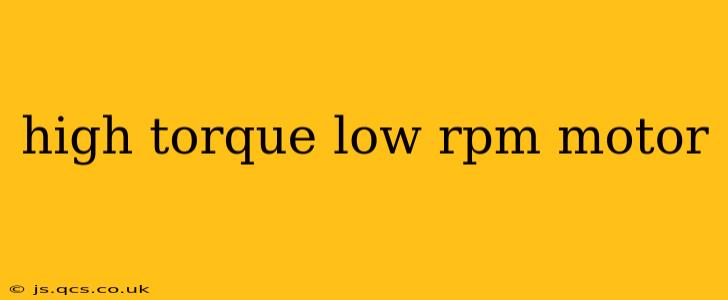High torque, low RPM motors are workhorses in various applications, offering powerful, controlled movement ideal for demanding tasks. Unlike high-speed motors that prioritize speed, these motors excel at generating substantial rotational force at lower speeds. This makes them perfect for situations requiring significant power to overcome resistance or drive heavy loads. Understanding their characteristics and applications is key to selecting the right motor for your needs.
What is a High Torque Low RPM Motor?
A high torque low RPM motor is designed to produce a large amount of rotational force (torque) at a relatively low rotational speed (RPM). This contrasts with high-speed, low-torque motors often found in applications like computer fans or electric drills where speed is prioritized over raw power. The key differentiator lies in the motor's design and construction, which prioritizes power output over speed. These motors are often larger and heavier than their high-speed counterparts to accommodate the components needed to generate this high torque.
How Do High Torque Low RPM Motors Work?
The principle behind high torque low RPM motors involves optimizing the motor's design for maximum torque production. Several factors contribute to this:
-
Gear Reduction: Many high torque low RPM motors incorporate a gearbox to reduce speed and amplify torque. The gearbox uses gears of different sizes to trade speed for power. A smaller gear driving a larger gear will result in a lower output speed but significantly increased torque.
-
Motor Design: The motor's internal design plays a crucial role. Features such as larger stator and rotor sizes, stronger magnets, and specialized windings all contribute to increasing torque output. Brushless DC motors (BLDC) are frequently chosen for their efficiency and ability to achieve high torque at lower RPMs.
-
Power Supply: The power supply to the motor is also a factor. A sufficient power supply is crucial to support the high current demands of a high-torque motor.
What are the Advantages of High Torque Low RPM Motors?
High torque low RPM motors offer several distinct advantages:
-
High Power Output: They can handle heavy loads and demanding applications where substantial force is required.
-
Precise Control: Their lower speed allows for precise control over movement, making them suitable for applications requiring fine adjustments.
-
Durability: Their robust construction typically leads to increased durability and a longer lifespan.
What are the Applications of High Torque Low RPM Motors?
The versatility of high torque low RPM motors is evident in their widespread use across many industries:
-
Automotive: Electric vehicle traction motors, power steering systems.
-
Industrial Automation: Conveyor belts, robotic arms, material handling equipment.
-
Agriculture: Tractors, harvesters, irrigation systems.
-
Marine: Winches, cranes, propulsion systems.
-
Medical Equipment: Surgical robots, rehabilitation devices.
What are the Differences Between High Torque and High Speed Motors?
The fundamental difference lies in their primary output characteristic. High torque motors prioritize power and force, while high-speed motors prioritize speed and RPM. High torque motors typically have a higher current draw and lower speed, whereas high-speed motors operate at higher RPM with a lower torque output. Choosing the right type depends entirely on the application requirements.
How to Select a High Torque Low RPM Motor?
Choosing the right motor requires careful consideration of several factors:
-
Torque Requirements: Determine the amount of torque needed for your application.
-
Speed Requirements: Specify the desired RPM.
-
Operating Voltage: Select a motor compatible with your power supply.
-
Duty Cycle: Consider the motor's operational demands (continuous or intermittent).
-
Size and Weight: Factor in the physical constraints of your application.
What are Some Examples of High Torque Low RPM Motors?
Many types of motors can be designed or adapted for high torque, low RPM operation. Common examples include:
-
DC Motors (with gearboxes): These are frequently used in applications requiring relatively high torque and precise control.
-
AC Induction Motors (with gearboxes): Robust and efficient, ideal for heavy-duty applications.
-
Brushless DC (BLDC) Motors: Known for efficiency and precise control, often preferred for applications needing high torque and long lifespan.
Choosing the right high torque low RPM motor is crucial for optimal performance and efficiency. Understanding the motor's characteristics, advantages, and applications will ensure you select the best fit for your specific needs.
